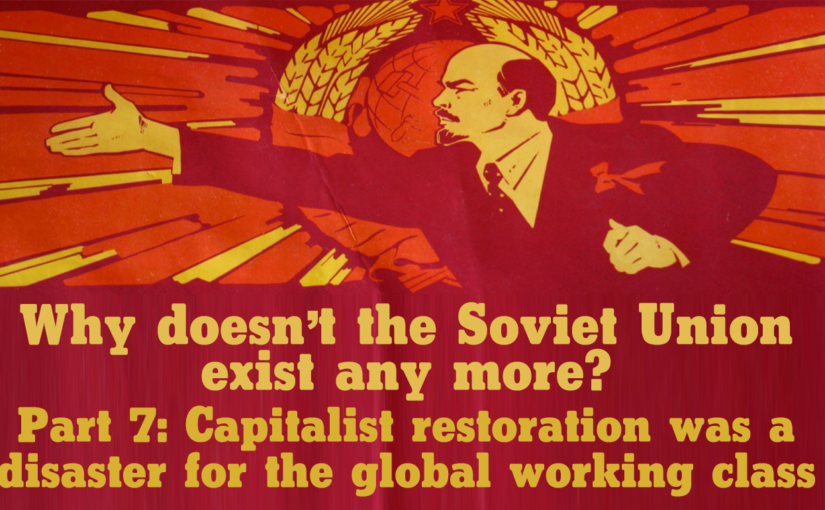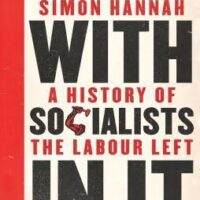There can be no more tragic spectacle in the history of humanity than that of a defeated revolution. When the revolt of the slaves in Rome was defeated, thousands were nailed to crosses on the roadside. This should give us an idea of what a defeated revolution is… There was also the dreadful slaughter of workers after the defeat of the Paris Commune [in 1871]. This, too, should give us an idea of what a defeated revolution is. History teaches us that a defeated revolution has to pay an extraordinary toll in blood. The victorious ruling class demands payment for the anxiety it experienced, for all the interests that were affected, or that were threatened. But it not only demands payment for present debts; it also seeks to collect, in blood, payment for future debts. It tries to annihilate the revolution down to its very roots. (Fidel Castro1)
A joke circulating in Russia in 1992 went like this. Q: What did capitalism accomplish in one year that communism could not do in seventy years? A: Make communism look good.2
From liberation to liberalisation
With the burden of Gorbachev’s social democratic fantasies lifted from his shoulders, Yeltsin went to work on behalf of his major constituency: the most corrupt and unscrupulous sections of the Russian nouveau riche, along with US finance capital. The goal was to totally wipe out the economic foundations of socialism and create a fully liberalised economy where capital would be free to reproduce without fear of restriction or regulation; an economic environment purpose-built for foreign investors, speculators, bankers and gangsters.
But, as Gregory Isaacs put it, “a rich man’s heaven is a poor man’s hell”. The welfare state was all but wiped out. The neoliberal economic advisors hired by Yeltsin – led by Jeffrey Sachs3 – mandated an end to price controls, meaning that the price of even the most essential commodities skyrocketed overnight. Unemployment went from practically nothing to over 12 percent within a few months. Asset-stripping reached dizzy new heights. Privatisation, deregulation and corruption were the order of the day, as production, government spending, earnings and even life expectancy plummeted: Kotz and Weir note that “from 1990 to 1994 male life expectancy in Russia fell from 65.5 years to 57.3 years… Such population decline normally occurs only as a result of major wars, epidemics, or famines.”4
As funding dried up, the healthcare infrastructure collapsed and the peoples of the former Soviet Union were subjected to epidemics of poverty-fuelled diseases not seen for many decades. “Azerbaijan has had a tenfold increase in measles, Uzbekistan suffered an outbreak of polio and typhoid fever has reappeared in Russia. Tuberculosis and syphilis are widespread, and the incidence of such children’s diseases as whooping cough and German measles has increased sharply”.5 Russia witnessed its first cholera epidemic since the 19th century.
In the first few years following the collapse of the Soviet Union, Russian GDP and industrial production both contracted by more than 40 percent. “By comparison, in the United States the four-year economic contraction in 1929-33, which brought the American economy to the low point of the Great Depression, entailed a decline in gross national product of 30 per cent”.6 Needless to say, wages followed suit, and the Soviet people started to suffer serious poverty for the first time in many decades. According to a World Bank report on the ‘transition economies’ (all the former socialist countries of Central Europe, Eastern Europe and Central Asia), the number of people living on less than 4 dollars per day increased from 14 million in 1989 to 147 million in the mid-1990s. In Russia this corresponded to an increase from 2 percent to 44 percent; in Ukraine from 1 percent to 63 percent; in Central Asia from 6.5 percent to 53 percent.7
It took around 15 years for Russian GDP to recover to 1990 levels – during which period China’s GDP increased by around 300%. Even after GDP had returned to 1990 levels, the obscene levels of inequality meant that millions of Russians still lived with a level of poverty that hadn’t been seen in the Soviet Union since WWII. New problems emerged, most noticeably homelessness (including youth homelessness), drug addiction, social alienation and prostitution, all of which remain endemic in Russia today. A 2012 article notes: “The rate of alcohol and drug abuse among teenagers has increased dramatically, as have delinquency and suicide rates, which are likely related to the growing incidence of domestic violence. By the mid-2000s, government spending on education per child dropped to half of the rate in 1990. Experts estimate that over 1.5 million children currently do not attend school.”8
Yegor Ligachev – one of the few members of the politburo in the late 1980s to resist the madness of glasnost – lamented:
During the years of Soviet power, a person was judged, not by his bag of loot, but by his labour, and lofty moral principles were reinforced: patriotism, internationalism, collectivism, industry, honour, justice. Now, all that is being stamped out of people’s consciousness and the historical connection is being broken. The current authorities and the mass media are encouraging the cult of gain, grovelling to the rich, contempt for the poor, speculation, hard drinking, prostitution and savage individualism.
Instead of the peace and quiet of the Soviet era, we are witnessing an unprecedented increase in crime and corruption, hundreds of thousands killed and wounded, and millions of refugees. All measures of development have taken a sharp downturn except mortality and crime – which are rising steeply. This is understandable. The property created by and belonging to the workers is being stolen, society is rife with alcoholism, and the number of unemployed and homeless is growing. The authorities cannot fight the very people they depend upon, that is, the speculators and the corrupt apparatus…
In the Soviet era … you could walk through any town at night without concern for your life; now murders and robberies are committed in broad daylight.9
The Soviet collapse also had a disastrous effect on cultural and social life. Michael Parenti points out that “subsidies for the arts and literature have been severely cut. Symphony orchestras have disbanded or taken to playing at block parties and other minor occasions. The communist countries used to produce inexpensive but quality editions of classical and contemporary authors and poets, including ones from Latin America, Asia and Africa. These have been replaced by second-rate, mass-market publications from the West. During the communist era, three of every five books in the world were produced in the Soviet Union. Today, as the cost of books, periodicals, and newspapers has skyrocketed and education has declined, readership has shrunk almost to Third World levels.”10 Racism, domestic abuse and violent crime all reared their ugly heads with the collapse of socialism.
No wonder a majority of Russians regret the collapse.11
Ironically, even elements within the western mainstream press now recognise that socialism offered a far better deal for ordinary people than neoliberal capitalism: “The planned economy of the vast Soviet Union offered financial stability. In the immediate aftermath of its 1991 crash, it quickly became apparent that Russia’s new market economy would offer a rocky ride. Economic reforms quickly had a harsh effect on general living standards. The rouble became almost worthless. Corruption was rampant. A deeply flawed privatisation programme helped put much of the country’s economy in the hands of an entrenched and often shady oligarchy.”12
It is now widely believed that US-led finance capital knowingly directed the post-Soviet Russian economy into disaster so as to: 1) thoroughly wipe out the economic roots of socialism by replacing it with gangster anarcho-capitalism; and 2) to prevent the Russian Federation from becoming a serious competitor to US hegemony in the ‘new world order’.
So much for democracy
Yeltsin in power confirmed what every thinking person suspected: he had not the slightest interest in democracy. The brutal neoliberalism imposed on the Russian people could never have enjoyed popular legitimacy – how to win widespread support for the dismantling of social welfare and the transfer of the state’s assets to a bunch of bureaucrats and crooks? Therefore a corrupt, plutocratic political system was installed that openly favoured the enormously wealthy and that actively excluded the poor.
In stark contrast to their role during Soviet times, trade unions were barred from political activity. Pro-communist and anti-Yeltsin media were routinely banned.13
By autumn 1993, Yeltsin was facing serious opposition even within the Russian parliament, a majority of whose members were appalled by the results of the neoliberal ‘reform’ and Yeltsin’s use of extraordinary executive powers to push his programme though. A constitutional crisis arose when Yeltsin decided to put an end to the pesky parliamentary opposition by dissolving the legislature (unconstitutional dissolution seems by this point to have become something of a habit). The parliament responded by denouncing Yeltsin’s actions, impeaching him and declaring vice president Aleksandr Rutskoy acting president. The crisis was only ‘resolved’ when Yeltsin ordered the army to storm the Supreme Soviet and arrest the parliamentary leaders that opposed him. Quite the democratic transformation.
Stephen Cohen notes that “the most influential pro-Yeltsin intellectuals were neither coincidental fellow travellers nor real democrats. Since the late 1980s they had insisted that free-market economics and large-scale private property would have to be imposed on Russian society by an ‘iron hand’ regime using ‘anti-democratic measures’. Like the property-seeking elites, they saw Russia’s newly elected legislatures as an obstacle. Admirers of Chile’s Augusto Pinochet, they said of Yeltsin: ‘Let him be a dictator!’ Not surprisingly, they cheered (along with the US government and mainstream media) when he used tanks to destroy Russia’s popularly elected parliament in 1993.”14
Three years later, in 1996, the Russian presidential elections were almost certainly fixed so as to maintain Yeltsin in power at the expense of the Communist Party candidate, Gennady Zyuganov.15
Yeltsin portrayed himself as the ‘father of Russian democracy’; in reality he was its leading assassin.
Global tragedy
The destruction of socialism in the USSR … inflicted terrible damage on all peoples of the world and created a bad situation for the Third World in particular. (Fidel Castro16)
The importance of the USSR’s role as a counterweight to US/Nato imperialism was made achingly clear by the series of imperialist wars that took place during and after the Soviet demise. Symbolic of this shifting power balance is Saddam Hussein’s misplaced hope in early 1991 that Gorbachev would act to restrain US warmongering against Iraq.17 The Soviet Union was supposed to be a great power, a longstanding ally of Iraq, with its Armenian borders extending to within a couple of hundred kilometres of Iraqi Kurdistan, and Gorbachev’s government did nothing to protect Iraq from invasion by a predatory imperialist power on the other side of the world. It’s rather difficult to imagine Stalin or Brezhnev presiding over such a mockery.
Horrifically destructive US-led wars soon followed in Yugoslavia, Afghanistan, Iraq (again), Libya and elsewhere. The campaign to destroy Syria’s independence continues to this day.
In the post-Cold War world order, neutrality was no longer tolerable. Many states quickly modified their nationalist orientation and semi-socialist policies to play by the rules of global capitalism, but only complete capitulation was accepted. Any country that contradicted Washington’s plans and erected some barriers to the penetration of imperialist capital could find itself in the crosshairs. Immediately after the fall of the Soviet Union, the U.S. attacked Iraq, and then, in the Clinton years Somalia, Sudan, Haiti and Yugoslavia… After launching a ‘demonstration’ war against Afghanistan in 2001, Bush declared an ‘axis of evil’ — Iraq, Iran and North Korea — a hit list for further regime change efforts.18
The balance of power in the world changed sharply, with the overwhelming majority of European socialist states being replaced by right-wing governments and incorporated into Nato (despite the promises made by the US and West Germany that there would be no eastward expansion of Nato).19 The economic crisis occasioned by the Soviet collapse also led to the demise of socialism in Mongolia.
With China yet to become the economic powerhouse it now is, underdeveloped countries in need of investment were left with no choice but to look to the US and the Bretton Woods institutions. As a result, ‘structural adjustment’ became the order of the day, and many poorer countries had no choice but to accept privatisation and austerity on a grand scale in exchange for loans that were desperately needed to avert acute crises.
Of the remaining socialist countries, Cuba, Vietnam and DPR Korea suffered particularly badly as a result of the sudden disappearance of the Soviet Union (and its friendly trade terms). It is a testament to the remarkable courage, creativity and vision of the Cuban, Vietnamese and Korean people that those countries have recovered from the shock of the early 1990s and continue building socialism today.
The collapse of the Soviet Union and European socialism could reasonably be described as the worst defeat suffered by the global working class in its history. It gave a lifeline to imperialism and set back the cause of human liberation by several decades.
The next, and final, article in this series attempts to answer the question: Will the People’s Republic of China suffer the same fate as the Union of Soviet Socialist Republics? In doing so, it will suggest a few conclusions from the preceding articles and outline some ideas around advancing the struggle for socialism in the coming decades.
-
May Day rally in Havana, 1961. Cited in The Fidel Castro Reader, Ocean Press, 2003 ↩
-
Parenti, Michael: Blackshirts and Reds, City Lights Publishers, 2001 ↩
-
For further information on Sachs’ role, see New York Times: Dr. Jeffrey Sachs, Shock Therapist ↩
-
David Kotz, Fred Weir: Revolution From Above – The Demise of the Soviet System, Routledge, 1997 ↩
-
LA Times: Infectious diseases flourishing in former USSR as living standards fall ↩
-
Kotz and Weir, op cit ↩
-
These figures sourced from Socialist Action: 10 Years After 1989 ↩
-
Institute of Modern Russia: Russia’s Invisible Children ↩
-
Inside Gorbachev’s Kremlin: The Memoirs Of Yegor Ligachev, Westview Press, 1996 ↩
-
Parenti, op cit ↩
-
That most Russians regret the Soviet collapsed is well established by a number of opinion polls. See for example RT: Most Russians regret USSR collapse, dream of its return, poll shows ↩
-
Washington Post: Why do so many people miss the Soviet Union? ↩
-
See, for example, UPI: Anti-Yeltsin media banned, liberal paper attacked by militants ↩
-
The Guardian: The breakup of the Soviet Union ended Russia’s march to democracy ↩
-
This is even admitted by the US media these days. For example Time: Did Boris Yeltsin Steal the 1996 Presidential Election? ↩
-
Tomás Borge: El Nuevo Diario Interview with Fidel Castro ↩
-
New York Times: Hussein Wanted Soviets to Head Off US in 1991 ↩
-
Imperialism in the 21st Century: Updating Lenin’s Theory a Century Later, Liberation Media, 2015 ↩
-
Spiegel Online: Did the West Break Its Promise to Moscow? ↩


